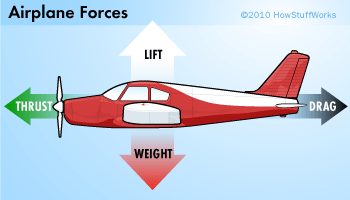Dynamics of Planes
Planes come in many different sizes and shapes, but what makes them fly? As they are taking off, their speed is increasing from the thrust (in the direction of motion) while drag increases (in the opposite direction of motion). Note the forces is opposite directions are equal as Lift = Weight and Drag = Thrust when in flight. The change in flight will depend on when one of the forces overcomes the other such as thrust being less then drag, then the plane slows down. If lift is greater than weight then the plane will lift up and vise versa when the opposite happens.

Now we know what's happening force wise but what's changing these forces? Powerful engines that create large amounts of thrust and special instruments that change the position of the aircraft.

The Pitch is changed by using the elevator, which can move the plane up or down (vertical motion). The Roll and Yaw are changed by the rudder and aileron to change the position left or right (horizontal motion). In order for them to turn, they have to bank using these instruments. These instruments are crucial for the movement of the plane, especially when it takes off!

From this image, we can see that the airflow is what creates the lift. This is done by lowering the ailerons which will in turn, if going fast enough create enough lift to lift the plane and put it in flight. The equation for both lift and drag is the same (only with one different variable).
Drag = Lift = 1/2 * Density * (Lift or Drag Coefficient) C * Velocity^2 * Surface Area
This is how to calculate the forces of drag and lift. These are simplistic mechanics of flight and it only gets more difficult from here as the change in angles will have to be accounted for, the different types of planes, and much more!
Images from:
http://s.hswstatic.com/gif/airplane-forces2.gif
http://www.grc.nasa.gov/WWW/k-12/UEET/StudentSite/dynamicsofflight.html
http://ffden-2.phys.uaf.edu/211_fall2010.web.dir/devon_fitzpatrick/newtonian.html